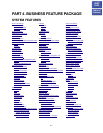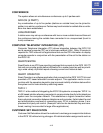Caller ID ON SMDR
The Station Message Detail Records report can be set to include Caller ID name
and Caller ID number for incoming calls. This format expands the printout to 113
characters. Use a wide carriage printer or an 80 column printer set for condensed
print.
NUMBER TO NAME TRANSLATION
The system provides a translation table for 350 entries on iDCS 100. When the
Caller ID number is received, the table is searched. When a match is found, the
system will display the corresponding name.
Caller ID SEND
The CID Send feature works in conjunction with the DID numbers assigned to a PRI
trunk. When an outgoing call is made over the PRI the system can be programmed
to send as caller id the did number associated with that station.
CALL FORWARDING
This feature allows the user to redirect (forward) incoming calls. The calls can be
redirected to the attendant, a hunt group, voice mail, external number or another
station user. If the destination station is in Do Not Disturb (DND), the calling party
will receive DND/Reorder tone. Calls cannot be forwarded to a door phone.
ALL CALLS
This type of forwarding is not affected by the condition of the station. All calls are
immediately redirected to the designated destination. If desired, the destination
station may redirect the call back to the forwarded station by using the transfer
feature. The forwarded station user can continue to originate calls as usual. If no
key is programmed as Forward All, the TRSF key lights steady when a Forward All
condition is set.
BUSY
This feature forwards all calls only when the station set is busy. The station user can
originate calls as usual.
NO ANSWER
This feature forwards calls that are not answered within a preprogrammed time.
The user can originate calls as usual and receive call if present. The timer is pro-
grammable on a per-station basis to allow for differences in individual work habits.
BUSY/NO ANSWER
This feature allows the station user to use both types of forwarding simultaneously,
provided the destinations have already been entered in the usual manner.
4.8
HOME
PAGE
Table of
Contents


















